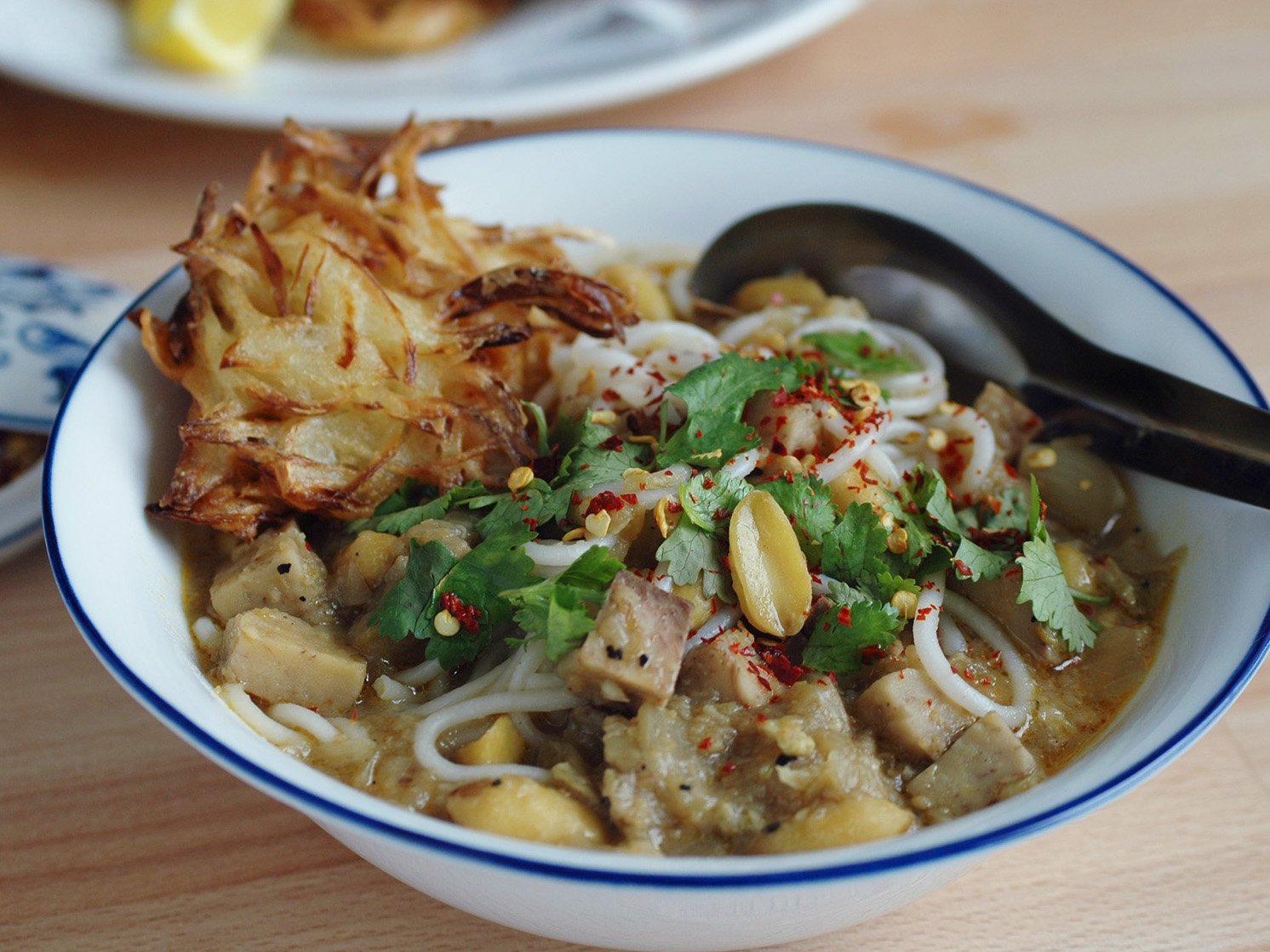
My mother recalls eating this vegetarian Mohinga recipe which was eaten during the nine days of the vegetarian festival. Each year on the first day of the ninth lunar month of the Chinese calendar, usually late September or early October, it was a tradition that the Chinese descendants followed in order to gain merit. Vegetarian in Burmese literally translate as ‘without killing’.
The unusual combination of purple yam and peanuts make the soup hearty and surprisingly taste very similar to the traditional fish noodle soup.
for the soup
2 medium onions, quartered
3 garlic cloves
2cm fresh ginger
6 tablespoons peanut oil
½ teaspoon ground turmeric
½ teaspoon paprika
4 tablespoons ground rice, roasted
1.5 litres vegetables stock/water
75g raw peanuts, shelled
10 shallots, peeled
250g purple yam, peeled & cubed
peanut oil to deep fry
2 tablespoons light soy sauce
plenty of black pepper
eat with
500g rice noodles, cooked
fresh coriander, chopped
lemon or lime, quartered
dried chilli flakes
crispy onion or gourd fritters
Using a pestle and mortar, pound the onion, garlic and ginger into a coarse paste. Heat the oil in a large saucepan and fry the onion paste for 5-10 mins until softened. Stir in ground turmeric and paprika.
Pour in the ground rice then water, stirring until the ground rice is incorporated. Add peanuts and shallots, bring to the boil. Let the soup simmer while you prepare the yam.
Pour enough oil in a small sauce pan to deep fry, about a third of the way. Fry the yam in batches until lightly golden all over. This will prevent the yam becoming mushy in the soup. Drain on kitchen paper.
Continue to simmer the soup until the peanuts are very soft but still hold their shape. Add the soy sauce, fried yam and black pepper. Check for seasoning before serving.
serves: 4
cooking time: 55-65 mins

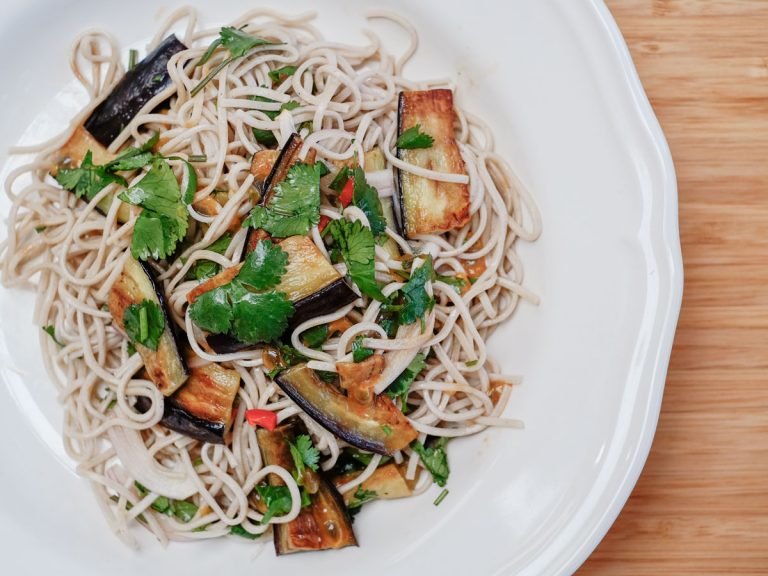
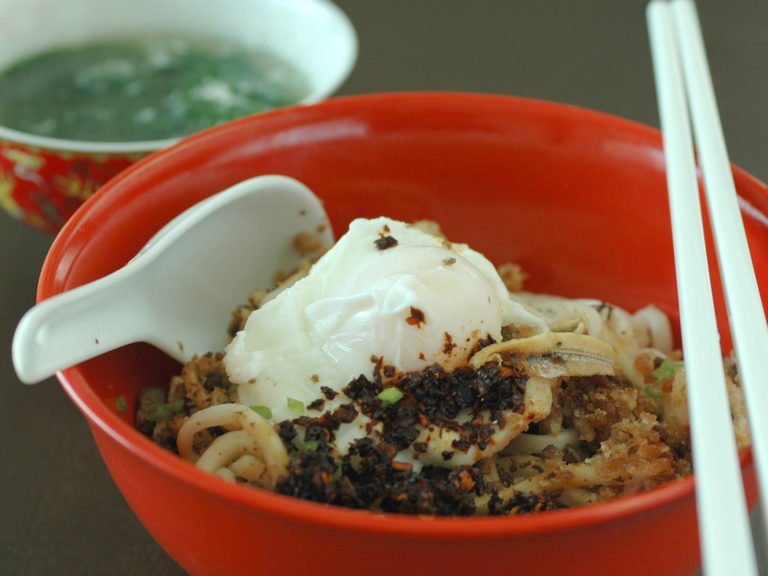
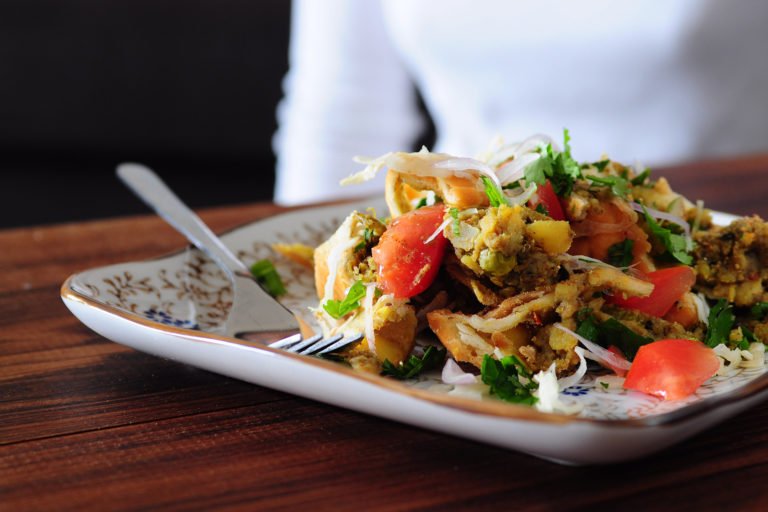
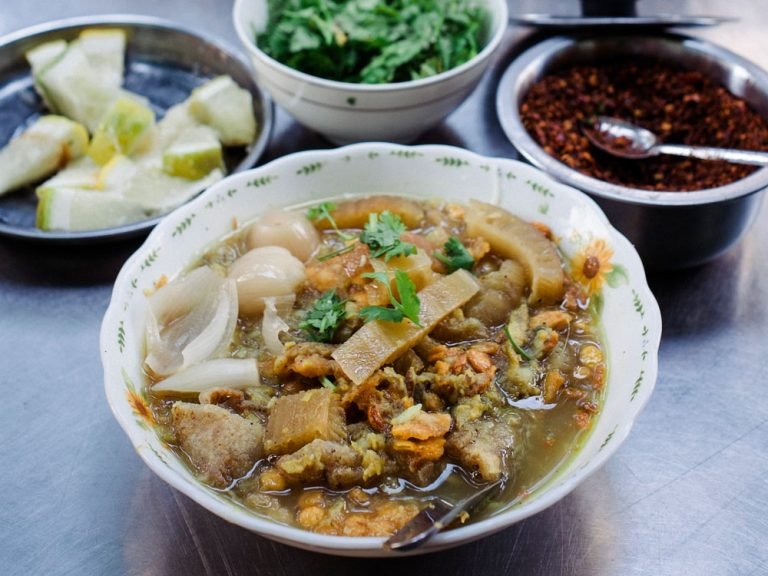


Thank you very much Cho. I have been looking this Vegetarian Mohingar for so long.
Hi Cho,
My wife Roz used to love Mohingar but then became vegetarian about 4 years ago and I’ve hardly made it since. I am looking forward to trying this vegetarian recipe and will let you know what she thinks. Many thanks – and I can reccommend your book to anyone. Brilliant!
Hi Yadana & Chris
Thank you for your messages. I’ve just recently discovered another great vegetarian recipe from my mother – this time for ngapi kyaw (dried shrimp relish) using dried Chinese mushrooms! I’ll put up the recipe once I’ve tried it.
– Cho
Thanks again Cho!
hi,Cho
I love your vegetarian Monhingar, it is really delicious. Now I am looking forward to taste your vegetarian nga-pe kyaw. Thank again.
Hi Nyunt
I’m in the process of building up a collection of Chinese dried mushroom stalks for the ngapi kyaw. Hopefully will post up a recipe soon.
– Cho
Hello ! As a vegetarian since my teens this recipe looks quite tasty; correct me if I’m wrong, but after a quick perusal of the book – which I recently obtained – it doesn’t make an appearance.
Also, I’ve never really liked yams myself; could you say whether their use here is more as a garnish, or if they actually supplement the flavour of the stock. Cheerio !
Hi Eugene
Thanks for your message. Vegetarian mohingar recipe was something I discovered from my mother after the book went to print! There are many more great vegetarian recipes I’m trying to uncover from my family. I’ve made a vegetarian version of ngapi kyaw (dried shrimp relish) so will be posting that on the blog this week.
As for yams, if you don’t like the taste perhaps try using sweet potato. It will taste a little different as the yam does add to the flavour of the dish.
– Cho
Thank you very much for vegetarian dishes you are sharing with us. I really appreciate about your generosity!
There are many types of yam. In this particular dish only purple yam is used. Those who do not like yam can substitute deep fried tofu, but it would not taste that good.
come on Cho, if you dont have fish in mohingar then that’s “NOT MOHINGAR” I’am sorry,fish is what makes MOHINGAR!!!!!!!!!
I understand what you mean Norm 🙂
Delicious Recipes
Awesome effort
Keep up the good work
For Vegetarian Recipes Visit http://vegetarianspot.blogspot.com/
Thanks for the link Wajid
Hi Cho.
I’ve recently been invited to do a guest spot on 209radio in Cambridge, UK on the Happy and Healthy Hour. Last week I did a Burmese Quorn Curry (Chicken-style chunks) with the help of your book. This week I cooked it for the show’s presenter John Levine and 14 guests and they all loved it. My recipe is on my blog crispychris.com. See what you think and let me know.
Best wishes, Chris.
Thanks for the message Chris. Your Quorn Curry looks great. Look forward to reading about the Cookery School. Keep me posted.
– Cho
Hi Cho,
There are lots of different kinds of peas and beans in the supermarkets and asian groceries but none of them are similar to our Pe Pyoke. For me,soy beans when cooked do not have the same flavour and it tastes different too. The closest one we can get here in australia is the blue boilers or blue boiling peas. You can find it anywhere easily. Just soak it overnight and cook it in a rice cooker with a little baking soda, with water just covering the peas.It tastes the same in Pe Pyoke htamin gyaw, and pe palata.
Cheers, Maw Maw
Hi Cho,
Great job. I’m very happy to see Bumese recipe, I miss Burma. I finished Cookery & Culinary Arts in Deploma, your skill & style I love it.
Kala Pe(Chana Dal) is the best to use for Mohingar, you can buy Indian or Asian Market.
Hi Cho
Thank you for this recipe, I am part burmese but sadly I don’t know any burmese cooking or burmese language and so I have decided that I would take it upon myself to do things differently and make burmese cooking a part of my life and of who I am.
Thank you again.
Karishma
Thank you for sharing this great recipe Cho.. This looks really delicious..
I just made this for a vegetarian Burmese meal I cooked for friends – everyone loved it. Apart from me, no one ever had Burmese food before, so we just enjoyed it without any comparison to the real Mohingar. (We used sweet potato, as I couldn’t find purple yam in the shops I went to).
Thank you very much for this recipe!
This dish look so good. I thank you so much for sharing this recipe with us. It’s greatly appreciate it.
http://www.styleyourfood.com
I would like to get the recipe for making Peh gyaw ( fried bean ) to eat with Mohingar. Fried peh gyaw is round flat and crispy.
Thank you.
Marshall.